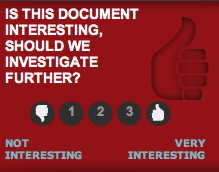Engaging People Around Your Data
Written by: Duncan Geere

Almost as important as publishing the data in the first place is getting a reaction from your audience. You’re human — you’re going to make mistakes, miss things and get the wrong idea from time to time. Your audience is one of the most useful assets that you’ve got — they can fact-check and point out things that you may not have considered.
Engaging that audience is tricky, though. You’re dealing with a group of people who’ve been conditioned over years of internet use to hop from site to site, leaving nothing but a sarcastic comment in their wake. Building a level of trust between you and your users is crucial — they need to know what they’re going to get, know how they can react to it and offer feedback, and know that that feedback is going to be listened to.
But first you need to think about what audience you’ve got, or want to get. That will both inform and be informed by the kind of data that you’re working with. If it’s specific to a particular sector, then you’re going to want to explore particular communications with that sector. Are there trade bodies that you can get in touch with that might be willing to publicize the resources that you’ve got and the work that you’ve done to a wider audience? Is there a community website or a forum that you can get in touch with? Are there specialist trade publications that may want to report on some of the stories that you’re finding in the data?
Social media is an important tool, too, though it again depends on the type of data that you’re working with. If you’re looking at global shipping statistics, for example, you’re unlikely to find a group on Facebook or Twitter that’ll be especially interested in your work. On the other hand if you’re sifting through corruption indices across the world, or local crime statistics, that’s likely to be something that’s going to be of interest to a rather wider audience.
When it comes to Twitter, the best approach tends to be to contact high-profile figures, briefly explaining why your work is important, and including a link. With any luck, they’ll retweet you to their readers, too. That’s a great way to maximize exposure to your work with minimum effort, though don’t badger people!
Once you’ve got people on the page, you need to think about how your audience going to interact with your work. Sure, they might read the story that you’ve written and look at the infographics or maps, but giving your users an outlet to respond is immensely valuable. More than anything it’s likely to give you greater insight into the subject you’re writing about, informing future work on the topic.
Firstly, it goes without saying that you need to publish the raw data alongside your articles. Either host the data in comma-separated plain text, or host it in a third-party service like Google Docs. That way, there’s only one version of the data around, and you can update it as necessary if you find errors in the data that need correcting later. Better still, do both. Make it as easy as possible for people to get a hold of your raw materials.
Then start to think about if there’s other ways that you can get the audience to interact. Keep an eye on metrics on which parts of your datasets are getting attention — it’s likely that the most trafficked areas could have something to say that you might have missed. For example, you might not think to look at the poverty statistics in Iceland, but if those cells are getting plenty of attention, then there might be something there worth looking at.
Think beyond the comment box, too. Can you attach comments to particular cells in a spreadsheet? Or a particular region of an infographic? While most embeddable publishing systems don’t necessarily allow for this, it’s worth taking a look at if you’re creating something a little more bespoke. The benefits that it can bring to your data can’t be underestimated.
Make sure that other users can see those comments too — they have almost as much value as the original data, in a lot of cases, and if you keep that information to yourself, then you’re depriving your audience of that value.
Finally, other people might want to publish their own infographics and stories based on the same sources of data — think about how best to link these together and profile their work. You could use a hashtag specific to the dataset, for example, or if it’s highly pictorial then you could share it in a Flickr group.
Having a route to share information more confidentially could be useful too — in some cases it might not be safe for people to publicly share their contributions to a dataset, or they might simply not be comfortable doing so. Those people may prefer to submit information through an email address, or even an anonymous comments box.
The most important thing you can do with your data is share it as widely and openly as possible. Enabling your readers to check your work, find your mistakes, and pick out things that you might have missed will make both your journalism, and the experience for your reader, infinitely better.
Duncan Geere, Wired.co.uk
